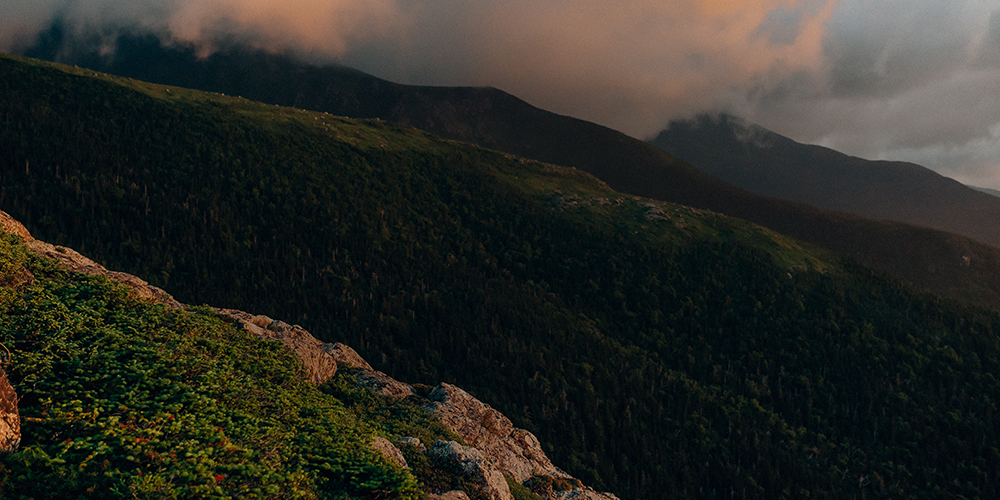White Mountains NH
One of the most dangerous seasonal challenges is weather. As a reminder, you should always check the weather right before you hike as it may change quickly. If you plan to hike Mt. Washington, or any of the 4000 footers, you should look at the Mt. Washington Observatory’s Higher Summits Forecast.
Winter
- In the winter, cold, wind and avalanches are the primary seasonal challenges. Forest Service snow rangers post avalanche warnings for Tuckerman and Huntington Ravines, which can be found online. Warnings and avalanche advisories are also posted at the Pinkham Notch Visitor Center, Tuckerman Ravine, Hermit Lake Shelters, Harvard Cabin, and the Androscoggin Ranger District Office.
- You must be prepared for extremes of cold, wind, snow and even rain. Skis or snowshoes are almost always needed. Even if there isn't much snow at the start of your trip, sudden storms can quickly appear and the amount of snow often increases as you climb and gain elevation.
- A minor injury can become life-threatening in the harsh winter environment. Be sure that someone knows your trip plans, and that you are prepared to spend the night if there is an emergency.
- Snow cover may make route finding difficult, so it is critical to know how to navigate with a map and a compass.
Spring
- Spring in the White Mountains can be like winter. Even when there's no snow in the valleys below, once you’re up in the mountains the snow can be very deep. This means that avalanche danger is still a consideration, as well as hypothermia.
- Water crossings are a serious hazard. In spring and after heavy rains, streams can change from trickles to torrents, making crossings difficult or impossible. If you decide to ford a stream, be extremely careful.
Summer
- In summer you can encounter extremes in temperatures from freezing cold to high heat and humidity, along with rapid changes in the weather. For this reason, hypothermia remains an acute danger.
- Due to frequent high heat, you should be extremely cautious of heat exhaustion, heat stroke and dehydration.
- Asthma and other respiratory conditions may be triggered by heat. Make sure to be prepared with all appropriate medications.
Fall
- The days are shorter and darkness comes early in the forest and mountains, especially in fall. Plan your hike so you're at the end before dark.
- During fall many trails become blanketed with a mat of leaves. Newly fallen leaves can, in effect, camouflage a hiking trail and make navigation more difficult. Wet leaves on a steep trail are also very slippery, so you should walk with caution.
- Temperatures during the fall months change dramatically during the course of a day. When the sun drops over the horizon, temperatures drop rapidly.
- You may experience winter conditions at any time in the fall, including snow and high winds.
Hunting season
- While most of us associate hunting season with fall and early winter, May is also hunting season for select species. Dress in bright colors - blaze orange is recommended. Call ahead if you have any concerns.
Insects
- Swarms of black flies and ticks are a problem throughout the spring and summer. Thus, you should always have insect repellent, which will keep the worst of them away.
- You should be especially cautious of ticks because lyme disease has been reported in New Hampshire. A daily inspection is a good habit, as the quick removal of ticks will minimize the risk of disease.
- More information can be found on the EPA and CDC websites.
If you see a wild animal - especially a moose or bear - exercise caution. Do not approach the animal. If you're in your car and want to observe the animal, pull over carefully and stay in your car.
- Unfortunately, even the innocent act of observing wildlife can have a great impact on the animal if it is not done properly.
- Enjoy wildlife from a distance. The goal of successful wildlife watching is to see animals without interrupting their normal behavior. Wildlife send clear signals you are too close when they stop feeding and raise their head sharply, move away, change direction of travel or appear nervous or aggressive.
- Don't feed the animals. While it may seem exciting at the time to have an animal eat out your hand, there are potential serious consequences. Some animals that become accustomed to handouts may lose their natural fear of humans, and become aggressive.
- Never chase or harass animals. In some cases, valuable energy resources needed for survival are used when animals are chased.
- Don't pick up orphaned or sick animals. Wild animals rarely abandon their young. In most cases the adults are nearby, waiting for visitors to leave before they return.
- Be considerate when approaching wildlife that is already being viewed. A loud noise or quick movement may spoil the experience for everyone.
- If you see any type of unusual behavior, such as an animal pacing back and forth, or signs of aggression, contact the NH Fish & Game Dispatcher at (603) 271-3361 or your local police.
Preventing bear problems: When black bears are fed, they quickly learn unbearlike behaviors. Sadly, this may lead to serious, often deadly, results for the bear. You can prevent this by following these simple guidelines:
- Never intentionally feed bears to attract them.
- Maintain a clean campsite. Leave No Trace
- Put food scraps in closed containers, not in the campfire.
- Do not cook or eat in your tent.
- Keep food and cooking gear separate from your sleeping area.
- Keep food in a closed-up vehicle or hang food at least 10 feet off the ground and 5 feet out on a limb that will not support a bear.
- What to do if confronted by a bear:
- If loud noises, sticks and stones don't scare off the bear, back away slowly.
- NEVER turn your back or run away from a bear as this can trigger its hunting instincts.
- Lie face down on the ground with your legs spread and your fingers interlaced behind your head. Your spread legs will keep the bear from rolling you over and exposing your abdomen, while your hands and fingers will protect your head and neck.
Preventing moose problems: Each year nearly 200 moose are killed on New Hampshire highways. Remember to "Brake for Moose" when driving on our highways.
- Female moose are extremely protective of their calves, and bulls in mating season are unpredictable. No one should ever approach these animals no matter how tolerant they appear.
Search and Rescue (SAR)
In New Hampshire, hikers who negligently cause themselves to become lost or injured - resulting in costly and dangerous rescues - may be billed for those rescue services. The State of New Hampshire and U.S. Forest Service spends hundreds of thousands of dollars per year on rescues. In addition to that, thousands of hours of time and personal equipment are provided by volunteers. These individuals put themselves at personal risk every time they set out to rescue a lost hiker. In 1982, volunteer Albert Dow, an experienced climber, lost his life in an avalanche while searching for negligent hikers.
Organizations who assist New Hampshire Fish and Game Department and U.S. Forest Service include:
- Androscoggin Valley Search and Rescue
- Appalachian Mountain Club
- Mount Washington Observatory
- Mount Washington Volunteer Ski Patrol
- Mountain Rescue Service
- New England K9 Search and Rescue
- New Hampshire Army National Guard
- New Hampshire Division of Parks and Recreation
- New Hampshire Outdoor Council
- Pemigewasset Valley Search and Rescue Team
- Randolph Mountain Club
- Stonehearth Open Learning Opportunities (SOLO)
- Upper Valley Wilderness Response Team
- Local fire departments
- Groups
Keeping your group size small is recommended. Specific group sizes may be stipulated in some areas, so check before you go. Groups must be left to 10 or less in designated wilderness. Most groups - such as Scout troops, school and church groups, and other groups led by volunteers don't need a permit to hike in the White Mountain National Forest. However, if your group is a commercial venture, such as a camp or college or guide service, you will need an Outfitter Guide Permit for trips in the National Forest. For more information, see the White Mountain National Forest website or contact the District Ranger office. - Backcountry campsites
The White Mountain National Forest has a wide variety of cabins, shelters and huts. The Appalachian Mountain Club also maintains a number of popular backcountry campsites in the White Mountains, most of which are located along the Appalachian Trail, and are managed under a cooperative agreement with the U.S. Forest Service. Reservations are NOT accepted. The sites are operated on a first-come, first-served basis. However, if you are planning a trip with six or more people, use the AMC's Group Notification System. For more on this, visit the camping section of the AMC website. Or call 603-466-2721. This notification is NOT a reservation. This does help lessen impacts on the backcountry, minimize overcrowding and increase everyone's enjoyment of the backcountry experience. - Hiking Above Treeline
- In the White Mountains, treeline ends at a surprisingly low elevation because of the harsh weather.
- The unspoiled beautiful terrain above treeline is a very unforgiving place when the winds rage and temperatures drop. Fog can be very disorienting and make route finding difficult, so you should be prepared with the proper equipment.
- Although appearing rugged, this area can be fragile and easily damaged. You should:
- Never pick any plants.
- Never go off the trail.
- Never camp above treeline, unless there are many feet of snow.
- Never start an open fire.
- Tuckerman Ravine
- Tuckerman Ravine, on the southeast shoulder of Mt. Washington in the White Mountain National Forest is famous for its challenging spring skiing and hiking.
- This can be a dangerous place for your dog, and pets are not allowed overnight at Hermit Lake Shelters. Be aware of your dog's location at all times.
- In late spring, the Lip and upper sections of the Tuckerman Ravine Trail are dangerous due to crevasses, ice and snow. You should also be alert for falling ice.
test your knowledge
are you prepared?
Answer four T/F questions to get your score.








